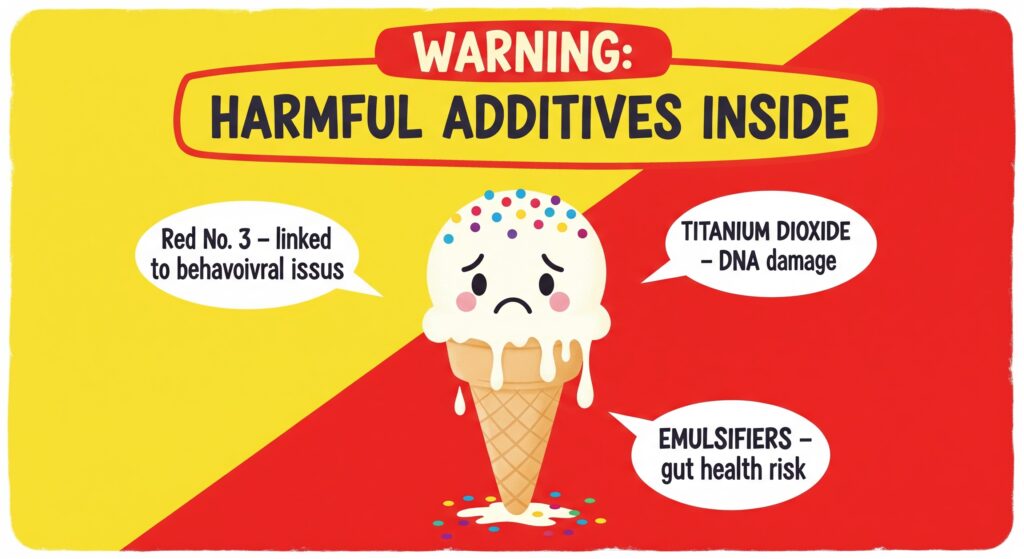Ice cream—who doesn’t love it? It’s creamy, sweet, and perfect for beating the heat. But when it comes to store-bought ice cream, parents may want to pause and think twice. Emerging science suggests that chemicals in commercial ice creams may impact children’s health.
Let’s break it down in simple terms and look at what the latest studies reveal.

Common Harmful Ingredients Used In Commercial Ice Creams
1. The Hidden Dyes: Red No. 3 and Titanium Dioxide
Many commercial ice creams contain food additives like Red No. 3 (a synthetic dye) and titanium dioxide (a whitener). These ingredients may sound harmless, but recent findings paint a different picture:
The Environmental Working Group (EWG) reported that titanium dioxide, commonly used to make ice cream look extra bright and smooth, can accumulate in the body and damage chromosomes—this is how it earned a ban in the European Union. Yet, it remains legal in the U.S.
Red No. 3 has also raised eyebrows. According to the California Office of Environmental Health Hazard Assessment, this dye is linked to behavioral issues in children, like decreased attention. It was deemed carcinogenic by the FDA in 1990, banned in cosmetics, but still allowed in food, except in California.
2. Emulsifiers: Not So Innocent After All
Emulsifiers help keep ice cream smooth and prevent it from separating, but emerging research suggests they may not be as innocent as once thought.
KFF Health News highlights that compounds like polysorbate 80 and carboxymethylcellulose—common ingredients in processed foods—can disrupt the gut microbiome, damage the gut lining, and even trigger inflammation, particularly in children.
A Wall Street Journal article notes that these emulsifiers are associated with higher risks of heart disease, Type 2 diabetes, and some cancers. Studies found they alter gut bacteria, potentially triggering body-wide inflammation.
Verywell Health adds that synthetic emulsifiers may contribute to inflammatory bowel diseases by damaging the gut barrier. Even natural ones like carrageenan (from seaweed) are flagged, with links to colon tumors in animal studies.
A large French study involving over 104,000 participants found that higher emulsifier consumption increased the risk of Type 2 diabetes—particularly with xanthan gum, which raised risk by 8%.
3. Why does Science Matter?
You might wonder—are these findings really relevant to kids? Some important context:
Many studies come from animal models or lab simulations. Still, they’re strong enough that scientists and health agencies are paying close attention.
Human trials are just starting. For instance, a small study showed that people eating carboxymethylcellulose for just 11 days had altered gut bacteria and even bacteria creeping into the mucus layer—something that could trigger inflammation.
Observational studies don’t prove causation but still reveal patterns worth noting.
Even though more research is needed, the clues are strong enough to raise caution—especially for children, whose bodies are still developing and may be more sensitive.
What’s the Impact on Your Child?
Putting it all together, here’s how store-bought ice cream might affect children:
Behavior & cognitive effects: Synthetic dyes like Red No. 3 may be linked to attention issues in sensitive kids.
Gut health & inflammation: Emulsifiers can disrupt the microbiome, weaken the gut lining, and potentially lead to gut inflammation or longer-term health issues.
Metabolic concerns: Repeated exposure to certain additives may increase the risk of diabetes or metabolic disorders later on.
How can you still enjoy treats while keeping things safer?
Read ingredient labels carefully. Avoid products listing “Red 3,” titanium dioxide, or “artificial colors.”
Pick simpler options. Go for brands that are organic or made with natural ingredients—EWG’s Food Scores tool can help you find cleaner ice creams.
Limit ultra-processed foods. Enjoy ice cream occasionally, not daily—and complement it with whole, minimally processed treats.
Make your own! Homemade ice cream recipe puts you in control—you can skip questionable additives, use fresh ingredients, and even sneak in fruit or yogurt.
Support gut health. Fill your home fridge with fiber-rich, whole foods like fruits, veggies, beans, and whole grains to balance the occasional treat.
Quick Recap Table
| Concern | What to Watch For | Source Highlights |
|---|---|---|
| Red No. 3 | Linked to cancer and attention issues | EWG |
| Titanium Dioxide | Causes chromosomal harm (EU banned) | EWG |
| Emulsifiers | Gut disruption, inflammation, chronic risk | KFF Health NewsWall Street JournalVerywell Health+1The Times |
| Human and Animal Data | Mice studies, small human trials | ZoeThe GuardianKFF Health News |
| Diet & Label Tips | Choose organic, whole foods, or make your own | EWGVerywell Health |
Conclusion
Between synthetic dyes tied to behavioral risks, emulsifiers that may disrupt gut health, and data linking these additives to inflammation and metabolic concerns, there’s real cause for thought.
Still, you don’t have to give up creamy treats forever. With mindful label-reading, choosing cleaner options, and especially making your own at home, you can keep ice cream as a joyful, occasional delight—without sacrificing health.

